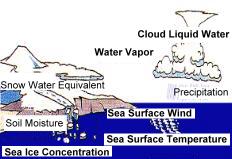Japan Aerospace Exploration Agency Earth Observation Research Center ALL RIGHTS RESERVED.
Exploring our water planet

Recently, interesting indications of "water" have been observed, such as the possibility of ice in the Moon's polar region and traces of floods on Mars' surface. Our planet Earth, however, is still the only one with rich and varied "water" sources as you can see.

Although solar radiation is the energy source of various phenomena in the Earth's surface layer, its budget and transport are largely dominated by water in three different phases: liquid water as ocean, land water, soil moisture, and cloud liquid water; solid water as snow ice, sea ice, and cloud ice; and the gaseous water as water vapor. Transportation of this phase-changing water, involving the latent and sensible heat exchange and the energy flux between atmosphere, ocean, and land, is the driving force of the Earth's system variation ranging from weather changes on short time scales to long-term climate changes. In contrast to that of Mars or the Moon, the average temperature of the Earth's atmosphere is stable within the current range. This is also due to the role of water. In other words, the water keeps our planet habitable. Water, in this way, is indispensable for the eco-system, including us, and distinguishes the Earth's environment.
There are still many issues to resolve to understand this water and energy circulation. There are great expectations that satellite observation will contribute to this area with its global and frequent observing capability. As core instruments of the ADEOS-II and Aqua platforms, AMSR and AMSR-E will perform continuous global measurement of various geophysical parameters related to understanding the water and energy circulation, and contributing to the detection of climate change signal.
|